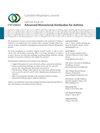非小细胞肺癌癌症患者血清sLOX-1的表达及其与脂质代谢的关系
IF 2.1
4区 医学
Q3 RESPIRATORY SYSTEM
引用次数: 2
摘要
目的探讨可溶性LOX-1(sLOX-1)在非小细胞肺癌癌症(NSCLC)患者血清中的表达水平及其与脂质代谢的关系。方法对99例NSCLC住院患者和81例健康对照者进行研究。比较两组患者血清sLOX-1水平,并分析sLOX-1与临床病理特征、血脂指标和癌胚抗原的相关性。结果非小细胞肺癌患者sLOX-1、低密度脂蛋白、甘油三酯和癌胚抗原水平均明显高于正常对照组(p < 0.05),而高密度脂蛋白的表达水平较低(p < sLOX-1在健康对照组患者血清中的表达水平与低密度脂蛋白呈正相关(r = 0.72,p < NSCLC患者血清sLOX-1和低密度脂蛋白水平与淋巴结转移、远处转移和TNM分期密切相关(p < 0.05)。与单一指标相比,sLOX-1与CEA联合应用时,其特异性显著提高至97.5%(AUC = 0.995,p < 结论sLOX-1和低密度脂蛋白在NSCLC患者血清中过表达,与TNM分期和转移密切相关。这一结果表明,脂质代谢紊乱可能通过sLOX-1促进NSCLC的进展,这可能是一种对NSCLC具有诊断价值的潜在血清学标志物。本文章由计算机程序翻译,如有差异,请以英文原文为准。
Expression of Serum sLOX-1 in Patients with Non-Small-Cell Lung Cancer and Its Correlation with Lipid Metabolism
Objective The aim of this study was to investigate the expression level of soluble LOX-1 (sLOX-1) in the serum of non-small-cell lung cancer (NSCLC) patients and its correlation with lipid metabolism. Methods 99 inpatients with NSCLC and 81 healthy controls were enrolled in this study. The levels of serum sLOX-1 were compared between the two groups, and the correlation of sLOX-1 with clinicopathological characteristics, blood lipid indices, and carcinoembryonic antigen was analyzed. Results Compared with the healthy controls, sLOX-1, low-density lipoprotein, triglyceride, and carcinoembryonic antigen in the patients with NSCLC were significantly higher (p < 0.05), while the expression level of high-density lipoprotein was lower (p < 0.05). The expression level of sLOX-1 in the serum of patients with healthy controls was positively correlated with low-density lipoprotein (r = 0.72, p < 0.05). The levels of sLOX-1 and low-density lipoprotein in the serum of patients with NSCLC were closely related to the lymph node metastasis, distant metastasis, and TNM stage (p < 0.05). Compared with a single index, when the sLOX-1 was combined with the CEA, its specificity increased significantly to 97.5% (AUC = 0.995, p < 0.01, 95% CI: 0.989–1.000). Conclusion sLOX-1 and low-density lipoprotein were overexpressed in the serum of patients with NSCLC, positively correlated, and closely related to the TNM stage and metastasis. This result suggested that lipid metabolic disorders may promote the progression of NSCLC through sLOX-1, which could be a potential serological marker with diagnostic value for NSCLC.
求助全文
通过发布文献求助,成功后即可免费获取论文全文。
去求助
来源期刊

Canadian respiratory journal
医学-呼吸系统
CiteScore
4.20
自引率
0.00%
发文量
61
审稿时长
6-12 weeks
期刊介绍:
Canadian Respiratory Journal is a peer-reviewed, Open Access journal that aims to provide a multidisciplinary forum for research in all areas of respiratory medicine. The journal publishes original research articles, review articles, and clinical studies related to asthma, allergy, COPD, non-invasive ventilation, therapeutic intervention, lung cancer, airway and lung infections, as well as any other respiratory diseases.
 求助内容:
求助内容: 应助结果提醒方式:
应助结果提醒方式:


